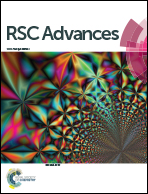Remarkable effects of substitution on stability of complexes and origin of the C–H⋯O(N) hydrogen bonds formed between acetone's derivative and CO2, XCN (X = F, Cl, Br)†
Abstract
The interactions of the host molecules CH3COCHR2 (R = CH3, H, F, Cl, Br) with the guest molecules CO2 and FCN (X = F, Cl, Br) induce significantly stable complexes with stabilization energies, obtained at the CCSD(T)/6-311++G(3df,2pd)//MP2/6-311++G(2d,2p) level, in the range of 9.2–14.5 kJ mol−1 by considering both ZPE and BSSE corrections. The CH3COCHR2⋯XCN complexes are found to be more stable than the corresponding CH3COCHR2⋯CO2 ones. The overall stabilization energy has contributions from both the >C![[double bond, length as m-dash]](https://www.rsc.org/images/entities/char_e001.gif) O⋯C Lewis acid–base and C–H⋯O(N) hydrogen bonded interactions, in which the crucial role of the former is suggested. Remarkably, we propose a general rule to understand the origin of the C–H⋯O(N) hydrogen bonds on the basis of the polarization of a C–H bond of a proton donor and the gas phase basicity of a proton acceptor. In addition, the present work suggests that the >C
O⋯C Lewis acid–base and C–H⋯O(N) hydrogen bonded interactions, in which the crucial role of the former is suggested. Remarkably, we propose a general rule to understand the origin of the C–H⋯O(N) hydrogen bonds on the basis of the polarization of a C–H bond of a proton donor and the gas phase basicity of a proton acceptor. In addition, the present work suggests that the >C![[double bond, length as m-dash]](https://www.rsc.org/images/entities/char_e001.gif) O group can be a valuable candidate in the design of CO2-philic and adsorbent materials, and in the extraction of cyanide derivatives from the environment.
O group can be a valuable candidate in the design of CO2-philic and adsorbent materials, and in the extraction of cyanide derivatives from the environment.


 Please wait while we load your content...
Please wait while we load your content...